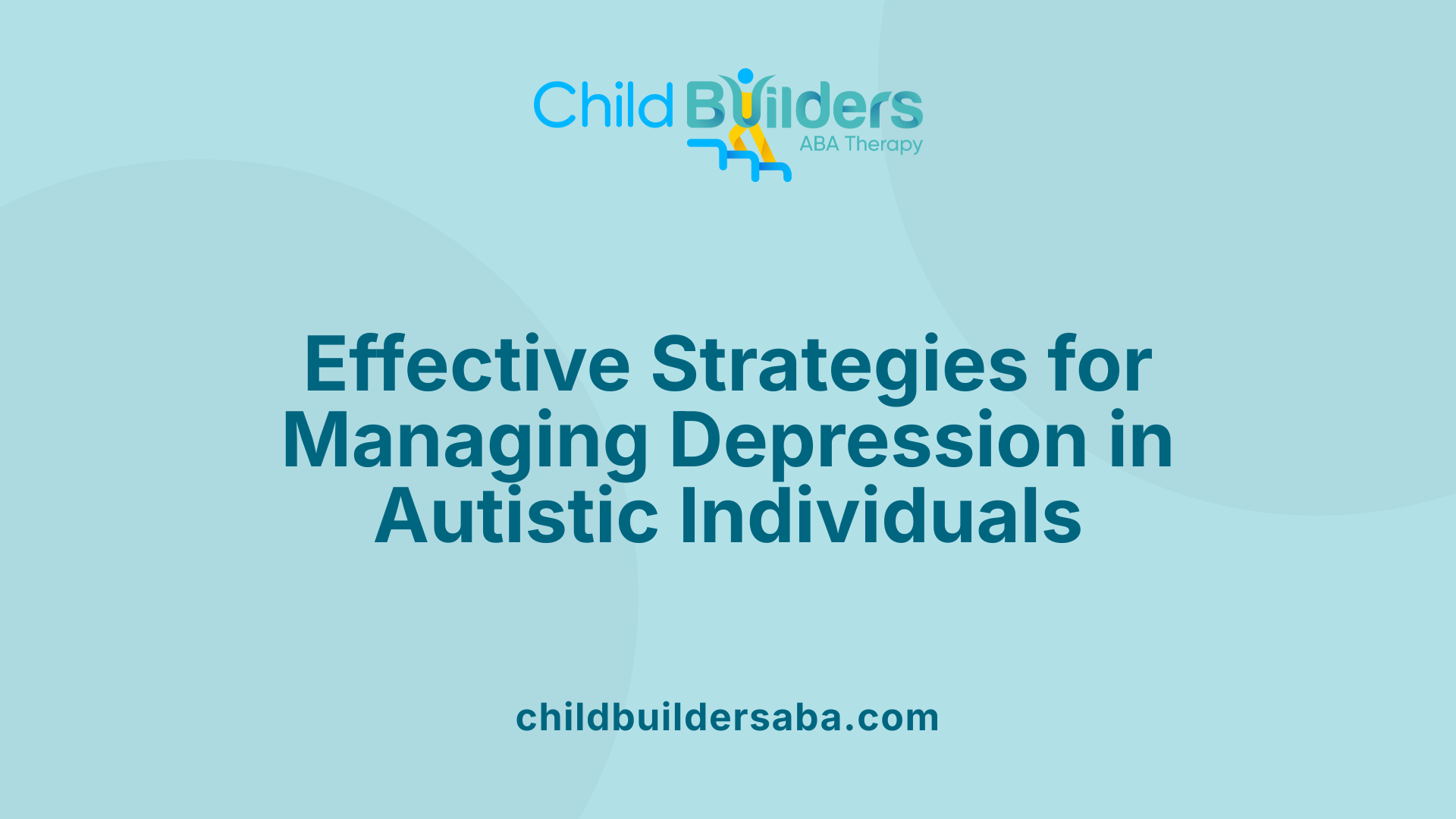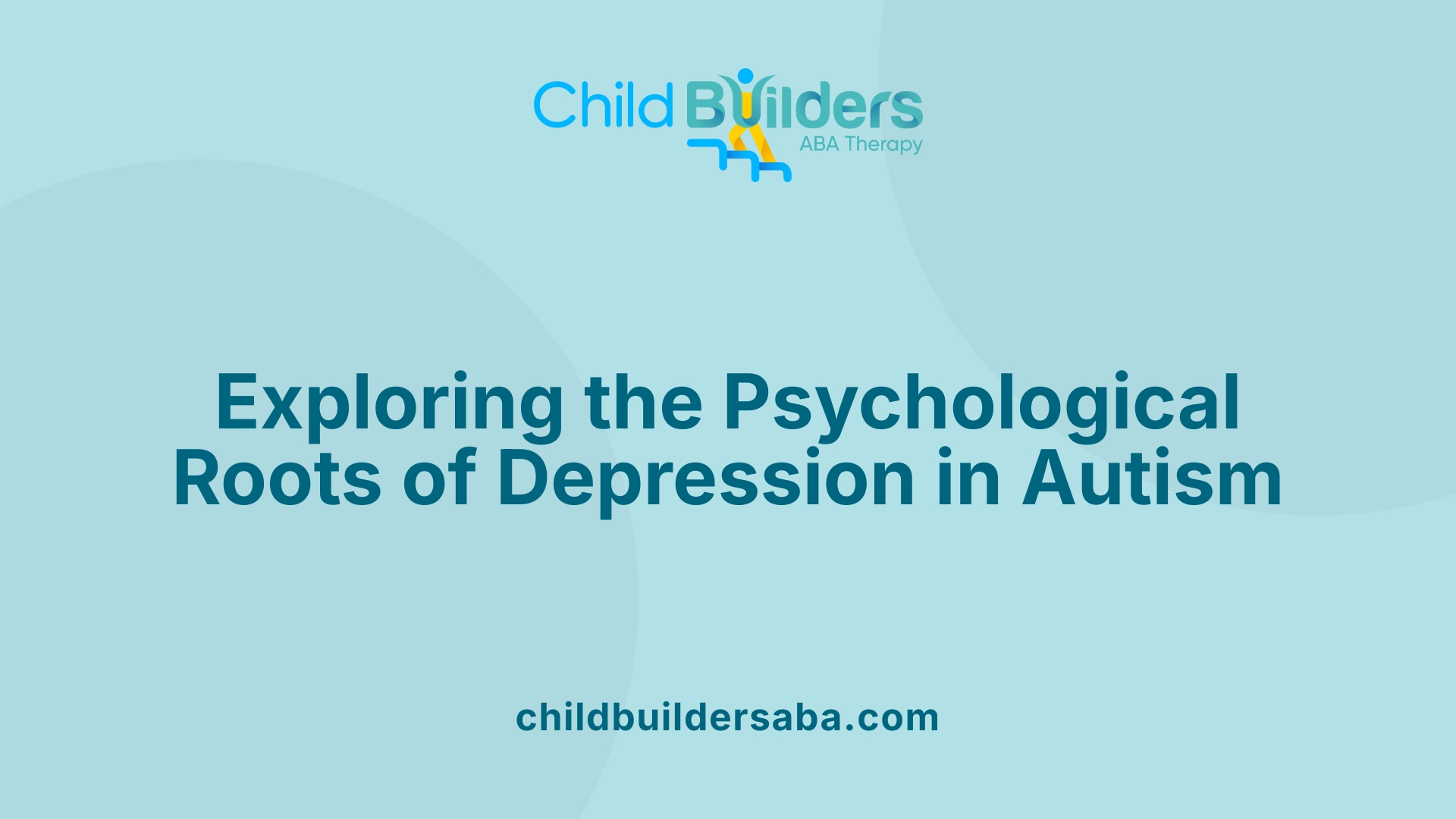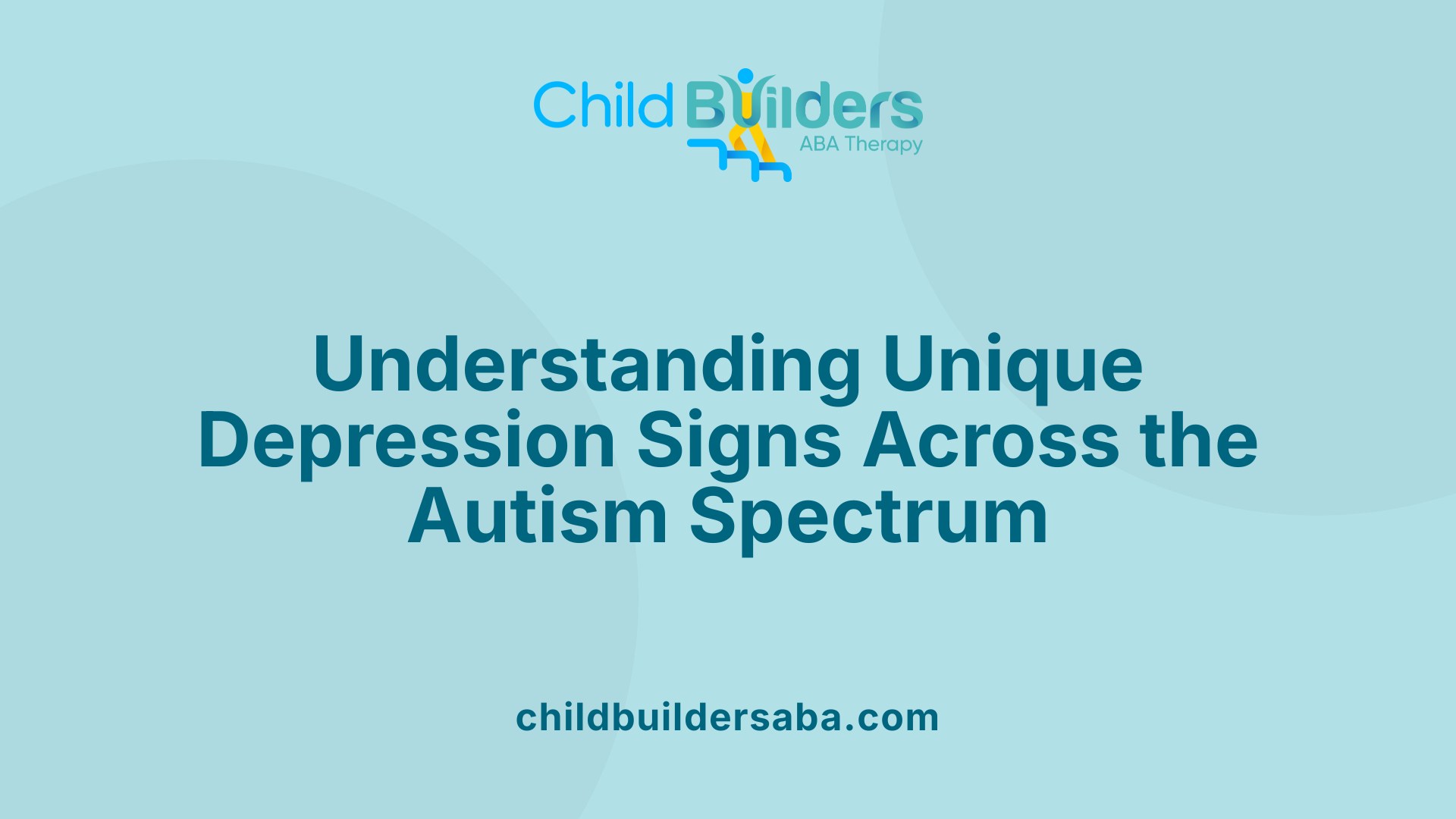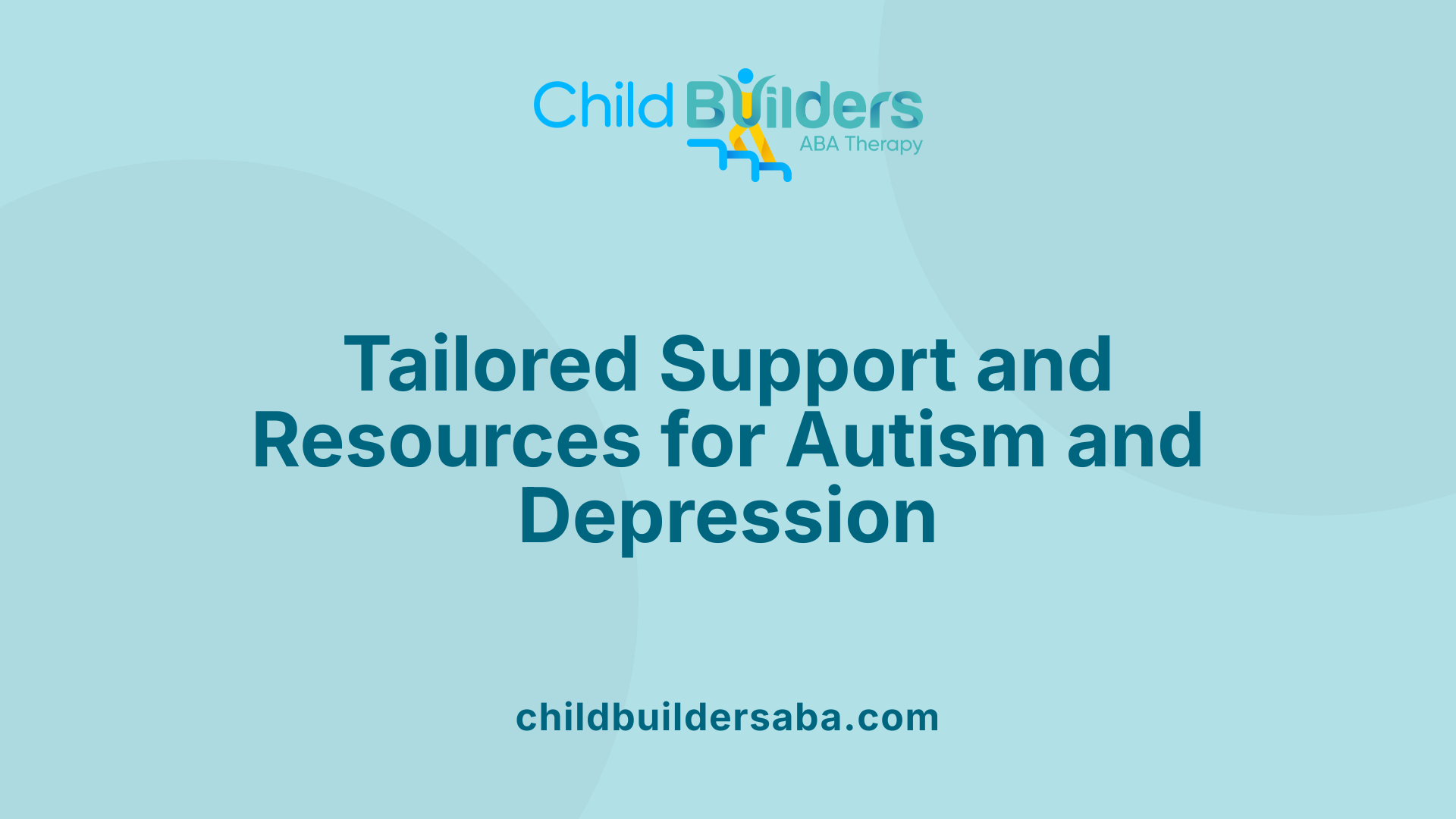Autism and Depression

Introduction to Autism and Depression
Autism spectrum disorder (ASD) and depression are deeply interconnected, with autistic individuals facing a disproportionately higher risk of developing depression than the general population. This article explores the intricate relationship between autism and depression, delving into symptoms, underlying causes, diagnostic challenges, treatment options, and the impact on individuals across age groups. Recognizing these complexities is essential for providing effective support and improving quality of life for autistic individuals experiencing depression.
The Prevalence and Significance of Co-Occurrence
What does current research say about the co-occurrence of autism and depression?
Recent studies reveal that depression is notably common among individuals with autism spectrum disorder (ASD). Research shows that up to 40% of autistic adults will experience depression at some point in their lives, with prevalence rates in the literature generally ranging from about 7% to 40%. Specifically, a 2019 review of multiple studies found that roughly 14% of autistic people will experience depression during their lifetime, while some estimates suggest this figure can reach as high as 50%.
The co-occurrence of autism and depression is more than just a statistical overlap; it poses critical challenges for diagnosis and treatment. Many depressive symptoms — such as social withdrawal, flat affect, sleep disturbances, and reduced motivation — are also common features of autism, making it difficult to distinguish one from the other. Consequently, depression in autistic individuals is often underdiagnosed or misdiagnosed.
Compared to the non-autistic population, autistic individuals are approximately four times more likely to experience depression. This heightened vulnerability links to various factors, including social isolation, difficulties understanding or expressing feelings, sensory sensitivities, and increased stress from navigating a neurotypical world. Additionally, comorbid conditions like anxiety, learning disabilities, or epilepsy further increase the risk.
The implications of this high prevalence are significant. Depression can severely impair daily functioning, independence, and overall quality of life for autistic individuals. It also increases the risk of suicidal thoughts and behaviors, which are alarmingly common — autistic adults are nine times more likely to consider suicide than their non-autistic peers.
Given these concerns, advocacy for routine mental health assessments among autistic populations is critical. Early detection and tailored interventions, such as adapted cognitive-behavioral therapy and mindfulness practices, are promising avenues that could improve mental health outcomes. Raising public awareness about the increased risk of depression in autism is essential to foster understanding, reduce stigma, and promote access to specialized mental health care.
Overview of Prevalence Rates and Implications
| Population Group | Estimated Depression Prevalence | Additional Notes |
|---|---|---|
| Autistic Adults | Up to 40% | Higher risk than general population; often co-occurs with anxiety and other conditions |
| Autistic Youth | About 8-14% | Underdiagnosis possible due to symptom overlap |
| General Population | 7-10% | Significantly lower compared to autistic individuals |
Understanding these disparities emphasizes the need for targeted mental health support and tailored treatment strategies to address this substantial public health concern.
symptoms and signs of depression in autistic individuals
What are common symptoms and signs of depression in autistic individuals?
Depression in autistic people often presents with a mixture of typical and atypical symptoms that can be more challenging to detect due to overlapping traits of autism. Common signs include persistent feelings of sadness, hopelessness, and irritability. Autistic individuals might also show a noticeable decrease in their interest in activities or special interests that previously brought joy, which is a hallmark of depression.
Changes in sleep patterns—such as insomnia or increased sleeping—along with appetite fluctuations and fatigue are frequent. Physical complaints like headaches or body pains may also be evident. Behavioral shifts are common, including increased social withdrawal, self-harm, and emotional outbursts like anger or aggression.
Recognizing depression can be complicated by communication difficulties; many autistic individuals have trouble expressing or even identifying their feelings, especially those with alexithymia. As a result, depression may manifest through behavioral changes rather than verbal communication.
Furthermore, symptoms such as mood swings, increased repetitive behaviors, and loss of interest in social activities can be mistaken for autism traits, delaying accurate diagnosis.
A particularly concerning aspect is the heightened risk of suicidal thoughts and attempts in autistic individuals, with studies indicating they are nine times more likely to consider suicide than neurotypical peers. This underscores the importance of caregiver and clinician awareness of the subtle and overt signs of depression.
In sum, understanding these signs is critical for early detection and intervention, which can significantly improve quality of life for autistic individuals.
Causes and risk factors for depression among autistic people
What are the causes and risk factors for depression among autistic people?
Depression in autistic individuals is influenced by a variety of interconnected factors. Genetic and neurobiological predispositions play a significant role, with evidence suggesting that both conditions are highly heritable. For instance, hyperserotonemia, an excess of serotonin in the brain, has been observed in some affected individuals, indicating a biological basis.
Environmental influences are equally impactful. Autistic people often face social rejection, bullying, or discrimination, which can heighten stress levels and contribute to depression. Traumatic experiences and life transitions such as changing routines or losing support systems can also act as triggers.
Social and emotional characteristics inherent to autism further increase vulnerability. Difficulties with social understanding and communication often lead to social isolation and loneliness. Sensory sensitivities can cause constant overstimulation and frustration, making daily functioning challenging. Additionally, alexithymia—an inability to recognize or describe feelings—can hinder emotional regulation, fostering feelings of hopelessness.
Cognitive factors, such as repetitive negative thinking and difficulty redirecting negative thoughts, are common in both depression and autism. Autistic individuals with higher self-awareness or more pronounced social challenges may internalize negative experiences, escalating their risk.
Other significant factors include a family history of mental health disorders, lack of adequate social support, and stressful events like relationship difficulties or loss. Because depression symptoms often overlap with autism traits—such as flat affect, reduced interest, or social withdrawal—accurate diagnosis and timely intervention are complex but crucial.
Understanding these diverse causes and risk factors underscores the importance of personalized approaches in preventing and treating depression within the autistic community.
Diagnostic challenges in depression within the autism spectrum

What are the challenges in diagnosing depression in autistic individuals?
Diagnosing depression in autistic people involves unique obstacles that stem from both overlapping symptoms and communication difficulties. Many symptoms of depression, such as social withdrawal, irritability, sleep problems, and changes in appetite, can be mistaken for core features of autism or may be considered typical variations in behavior. This symptom overlap can make it hard to distinguish whether a person’s behavior signals depression or simply reflects their autism.
Communication barriers further complicate diagnosis. Autistic individuals often have limited speech or expressive language difficulties, which can prevent them from clearly articulating feelings of sadness, hopelessness, or fatigue. As a result, healthcare providers may find it difficult to assess internal emotional states accurately. Atypical emotional expressions, like reduced facial affect or monotone voice, can also mask depressive symptoms, leading to underdiagnosis.
Another significant challenge involves the limitations of current assessment tools. Many standard depression inventories and diagnostic criteria have not been validated specifically for autistic populations. This lack of tailored instruments means that clinicians often rely on subjective judgment or caregiver reports, which can vary based on perceptions and biases. Furthermore, behavioral baseline differences mean that what might appear as signs of depression could be normal for certain autistic individuals.
In light of these challenges, a careful and individualized approach is essential. Clinicians typically need to gather detailed histories, observe for meaningful changes relative to an individual’s baseline, and incorporate insights from caregivers. Increasing awareness and developing validated assessment tools that account for autism-specific presentations are critical steps toward improving diagnosis. Overall, the complexity of overlapping symptoms, communication barriers, and limited diagnostic tools emphasizes the need for specialized training and nuanced evaluation methods.
For more information, searching "diagnosing depression autism challenges" can provide recent studies and guidelines that address these diagnostic hurdles and suggest tailored strategies for clinicians.
Treatment options and management strategies

What treatment options and management strategies are available for depression in autistic individuals?
Managing depression in autistic individuals requires a tailored approach, combining different therapies and interventions to best suit each person’s needs. Evidence shows that a mix of psychosocial and pharmacological strategies can be effective, but adaptations often are necessary to accommodate the unique challenges faced by autistic individuals.
One prominent therapy is modified cognitive-behavioral therapy (CBT). This adaptation involves adjusting techniques to suit individual communication styles, learning preferences, and sensory sensitivities. While some studies show promising results, the overall evidence is still limited, and more rigorous research is needed to confirm its effectiveness. Therapists experienced in autism are better equipped to deliver these customized interventions.
Regarding medication, antidepressants such as selective serotonin reuptake inhibitors (SSRIs) are frequently prescribed. However, their use must be cautious, as autistic individuals can experience different side effects or sensitivities. Close monitoring is essential to ensure safety and effectiveness. Other medications, including antipsychotics or mood stabilizers, might be considered, especially in cases of severe depression or co-occurring conditions like epilepsy.
Beyond traditional therapies, mindfulness-based programs and social skills training can help improve emotion regulation and social engagement. These approaches may be particularly beneficial in reducing feelings of isolation and improving quality of life.
Complementary strategies such as routine establishment, sensory accommodations, and supported social interactions are vital. Providing a safe, predictable environment fosters comfort and reduces stress, which can mitigate depressive symptoms.
In summary, effective management involves a comprehensive plan that combines adapted psychotherapies, medication when appropriate, and supportive interventions. Collaboration with healthcare professionals experienced in autism is crucial to navigating treatment options and adjusting strategies based on ongoing assessment and individual responses.
Psychological mechanisms linking autism and depression

What psychological mechanisms may underlie depression in individuals with autism?
Depression in autistic individuals often stems from various interconnected psychological factors. One prominent factor is difficulty with emotional regulation, which impairs their ability to process and manage emotional experiences effectively. Many autistic people struggle with mentalization, or the capacity to understand and interpret their own feelings and those of others.
This challenge in social cognition can diminish social self-efficacy and motivation, leading to increased feelings of loneliness and social withdrawal, both of which are significant risk factors for depression.
Another critical element is perceived control or mastery over one’s life. Autistic individuals frequently experience a low sense of control, especially when navigating a world that often does not accommodate their needs. This sense of helplessness can amplify feelings of hopelessness and despair.
Furthermore, worry and cognitive rigidity play major roles. Excessive worry about social situations or future events, combined with a tendency toward rigid thinking, can heighten stress levels and reduce coping capacity. This mental inflexibility makes it difficult to adapt to change, further increasing vulnerability to depression.
Research indicates that reduced psychological flexibility—or the inability to adapt thoughts and behaviors in response to emotional cues—correlates with higher depression risk among autistic people.
In sum, these psychological processes—difficulties with emotional regulation, impaired mentalization, perceived lack of control, and worry—interact complexly. They create a landscape in which depression can develop and persist, particularly when not addressed through tailored therapeutic interventions that focus on enhancing emotional coping skills and cognitive flexibility.
Impact of depression on autistic individuals
How does depression impact autistic children and adults?
Depression greatly affects autistic children and adults, often leading to a significant decline in their overall quality of life. Many experience increased social withdrawal, which can deepen feelings of loneliness and isolation. For some, depression intensifies existing behaviors such as repetitive actions, emotional outbursts, and meltdowns, making daily routines more challenging.
Autistic individuals are approximately four times more likely to develop depression than non-autistic peers. This heightened risk can be partly attributed to difficulties in social communication, challenges in understanding and expressing feelings, and the presence of co-occurring conditions like anxiety, learning disabilities, or epilepsy.
Unique features of autism, such as alexithymia—a difficulty in identifying and managing feelings—make recognizing and diagnosing depression complex. Symptoms may not always manifest as typical sadness or despair but can include flat affect, decreased interest in favorite activities, sleep disturbances, and increased irritability.
Feelings of low perceived control, known as mastery, and worries about social acceptance or independence are central to the link between autism and depression. These factors can serve as targets for specialized interventions aimed at improving emotional regulation and stress management.
The consequences of depression extend beyond emotional distress to impact developmental and emotional growth. In children, depression can hinder learning, communication, and social skills development. In adults, it can impair occupational functioning and personal relationships.
While various therapies, including adapted psychotherapy such as cognitive behavioral therapy (CBT), medication, and support strategies, have shown promise, challenges remain. Due to the overlapping symptoms and individual differences, further research is needed to develop and validate effective, autism-sensitive approaches for managing depression. Addressing depression promptly is crucial in reducing risks of self-harm, suicidal thoughts, and long-term developmental setbacks, ultimately supporting better mental health and daily functioning for autistic individuals.
Manifestation and diagnosis differences within the autism spectrum

How do manifestations and diagnosis of depression differ within the autism spectrum?
Depression manifests differently across individuals on the autism spectrum, making accurate diagnosis a challenge. Autistic adults and children often display atypical symptoms that do not always fit traditional depression criteria used for neurotypical populations.
In many cases, symptoms such as increased irritability, social withdrawal, or a decline in special interests are prominent. Autistic individuals may also experience emotional expressions like flat affect or reduced speech to a degree that complicates recognition of their internal emotional state.
Moreover, overlapping signs—like sleep disturbances, changes in appetite, and low energy—are common to both autism and depression, blurring the diagnostic picture. For example, reduced social engagement in someone with autism is typical, but when combined with persistent feelings of hopelessness or self-harm, it may point to depression.
Assessment tools initially designed for general populations may not be sensitive enough to detect depression in autistic individuals. As a result, clinicians often need to adapt their evaluation methods, such as incorporating behavioral observations and reports from caregivers.
Research indicates that factors like perceived lack of control (or low mastery) and chronic worry are shared risk elements for both autism and depression. These intrapersonal factors influence how stress and emotional distress manifest and are processed.
Overall, understanding the unique presentation of depression in the autistic spectrum requires careful differentiation between autism-related behaviors and genuine depressive symptoms. Professionals must be vigilant for subtle changes, such as increased aggression or regression, and use tailored diagnostic approaches to ensure accurate identification and appropriate intervention.
Resources and Support for Autistic Individuals with Depression

What support options and resources are available for autistic individuals experiencing depression?
Supporting autistic individuals who are dealing with depression involves a combination of tailored therapeutic interventions, community engagement, and practical strategies for enhancing well-being.
Therapeutic approaches such as cognitive-behavioral therapy (CBT), mindfulness-based therapy, and behavioral activation are often adapted to meet the unique communication styles and thinking patterns of autistic individuals. These therapies can help address negative thought patterns, improve emotional regulation, and foster resilience. Since depression may manifest differently in autism, treatment modifications are essential for effectiveness.
Medications, including antidepressants like selective serotonin reuptake inhibitors (SSRIs), may also be considered. However, healthcare providers must carefully monitor for side effects, as autistic individuals can be more sensitive to certain pharmacological treatments. Due to limited conclusive evidence on medication efficacy specifically for autism, combined approaches often yield better outcomes.
Beyond formal clinical treatments, community-based resources and social supports play a vital role. Support groups, social prescribing programs, and peer networks provide environments where individuals can connect, share experiences, and reduce feelings of isolation. These community supports contribute significantly to emotional well-being and can help prevent worsening depression.
Practical activities that promote mental health include engaging in enjoyable movement, spending time in nature, and maintaining consistent daily routines. Simple strategies such as ensuring proper sleep, a balanced diet, and regular physical activity can have a positive impact.
In summary, an individualized, comprehensive approach that integrates adapted psychotherapy, cautious medication use, and strong social support offers the best chance for effective management of depression in autistic individuals. Building a supportive environment that respects sensory sensitivities and special interests further enhances coping and recovery.
Resources and Support Options at a Glance
| Resource/Support Type | Description | Benefits |
|---|---|---|
| Psychotherapy (CBT, MBT) | Tailored mental health therapy | Addresses negative thinking, emotional regulation |
| Medication | Use of antidepressants with careful monitoring | Can alleviate depressive symptoms |
| Support Groups | Peer-led or professional facilitated groups | Reduce isolation, share coping strategies |
| Community Programs | Social prescribing and local outreach | Foster social connection, skill development |
| Lifestyle Activities | Nature, movement, routine management | Promote overall mental health |
By combining these supports, autistic individuals facing depression can find personalized pathways to recovery and well-being.
Closing Thoughts
Depression among autistic individuals presents a complex challenge that intersects with unique behavioral, emotional, and social factors. Understanding the distinct ways depression manifests and complicates diagnosis requires ongoing research, tailored intervention strategies, and increased awareness among healthcare providers and caregivers. The high prevalence of co-occurrence underscores the necessity for personalized, multidisciplinary approaches that prioritize early detection, compassionate care, and holistic support systems. Enhancing mental health services, developing autism-sensitive diagnostic tools, and fostering supportive environments are essential steps toward improving life quality for autistic people coping with depression. By addressing these issues comprehensively, society can foster understanding, reduce stigma, and ensure that autistic individuals receive the appropriate help they deserve.
References
- Depression and autism | What is autism? - Autistica
- Autism and depression are connected: A report of two ...
- Autism and depression: What is the connection?
- Depression - National Autistic Society
- [Autism, depression and risk of suicide] - PubMed
- Depression in autistic people: Symptoms, treatment, and more
- Autism and Depression: What's the Relationship? - Healthline
- Autism and Depression





.jpg)































































































